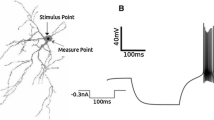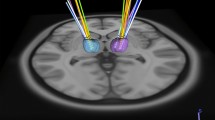Abstract
Spontaneous action potential bursts associated with low threshold calcium spikes (LTS) occur in multiple human lateral thalamic nuclei, each with different physiologic characteristics. We now test the hypothesis that different patterns of spontaneous LTS bursting occur in these nuclei during awake surgery in patients with essential tremor and the arm at rest. This protocol was chosen to minimize the effect of the patient’s disease upon thalamic activity which is a potential confound in a surgical study of this type. Neuronal activity was studied in the human thalamic nuclei receiving somatic sensory input (Vc, ventral caudal), input from the deep cerebellar nuclei (Vim, ventral intermediate), or input from the pallidum (Vo, ventral oral). In each nucleus the burst rates were significantly greater than zero. Burst rates were higher in Vc than in Vim, while firing rates were lower. These findings suggest that neurons in Vc are hyperpolarized and have more frequent inhibitory events. Pre-burst inter-spike intervals (ISIs) were significantly longer in Vc, but were significantly shorter when corrected for the average ISIs between bursts (burst rate/inverse of the primary event rate). These results suggest that inhibitory events in Vc are of lower magnitude relative to a hyperpolarized resting membrane potential. Studies in many species demonstrate that input from the pallidum to the thalamus is inhibitory, suggesting that input to Vo is predominantly inhibitory. However, neurons in Vo have neither slower firing rates nor more frequent LTS bursts. Previous studies have found that spontaneous LTS is similar between classes of neurons within Vc, as defined by their response to thermal and painful stimuli. The differences in spontaneous LTS between human nuclei but not between functional classes within a nucleus may be a basic organizing principle of thalamic inhibitory circuitry.




Similar content being viewed by others
References
Anderson ME, Turner DM (1991) Activity of neurons in cerebellar-receiving and pallidal-receiving areas of the thalamus of the behaving monkey. J Neurophysiol 66:879–893
Apkarian AV, Hodge CJ (1989) Primate spinothalamic pathways: III. Thalamic terminations of the dorsolateral and ventral spinothalamic pathways. J Comp Neurol 288:493–511
Cox DR, Lewis PAW (1966) The statistical analysis of series of events. Chapman and Hall, London
DeLong MR (1990) Primate models of movement disorders of basal ganglia origin. Trends Neurosci 13:281–285
Deuschl G, Bain P, Brin M (1998) Consensus statement of the Movement Disorder Society on Tremor. Ad Hoc Scientific Committee. Mov Disord 13(Suppl 3):2–23
Deuschl G, Krack P, Lauk M, Timmer J (1996) Clinical neurophysiology of tremor. J Clin Neurophysiol 13:110–121
Elble RJ (2002) Essential tremor is a monosymptomatic disorder. Mov Disord 17:633–637
Elble RJ, Koller W (1990) Tremor. Johns Hopkins University Press, Baltimore
Garonzik IM, Hua SE, Ohara S, Lenz FA (2002) Intraoperative microelectrode and semi-microelectrode recording during the physiological localization of the thalamic nucleus ventral intermediate. Mov Disord 17(Suppl 3):S135–S144
Hirai T, Jones EG (1989) A new parcellation of the human thalamus on the basis of histochemical staining. Brain Res Rev 14:1–34
Hua SE, Lenz FA (2005) Posture-related oscillations in human cerebellar thalamus in essential tremor are enabled by voluntary motor circuits. J Neurophysiol 93:117–127
Hua SE, Lenz FA, Zirh TA, Reich SG, Dougherty PM (1998) Thalamic neuronal activity correlated with essential tremor. J Neurol Neurosurg Psychiatr 64:273–276
Jahnsen H, Llinas R (1984a) Electrophysiological properties of guinea-pig thalamic neurones: an in vitro study. J Physiol 349:205–226
Jahnsen H, Llinas R (1984b) Ionic basis for the electro-responsiveness and oscillatory properties of guinea-pig thalamic neurones in vitro. J Physiol 349:227–247
Jankovic J (2002) Essential tremor: a heterogenous disorder. Mov Disord 17:638–644
Jeanmonod D, Magnin M, Morel A (1996) Low-threshold calcium spike bursts in the human thalamus. Common physiopathology for sensory, motor and limbic positive symptoms. Brain 119(Pt 2):363–375
Jenkins IH, Bain PB, Colebatch JG, Thompson PD, Findley LJ, Frackowiak RSJ, Marsden CD, Brooks DJ (1993) A positron emission tomography study of essential tremor: evidence of overactivity of cerebellar connections. Ann Neurol 34:82–90
Koller WC, Lyons KE, Wilkinson SB, Troster AI, Pahwa R (2001) Long-term safety and efficacy of unilateral deep brain stimulation of the thalamus in essential tremor. Mov Disord 16:464–468
Lee JI, Ohara S, Dougherty PM, Lenz FA (2005) Pain and temperature encoding in the human thalamic somatic sensory nucleus (ventral caudal): inhibition-related bursting evoked by somatic stimuli. J Neurophysiol 94:1676–1687
Lenz FA, Dougherty PM (1998) Cells in the human principal thalamic sensory nucleus (ventralis caudalis—Vc) respond to innocuous mechanical and cool stimuli. J Neurophysiol 79:2227–2230
Lenz FA, Kwan HC, Dostrovsky JO, Tasker RR (1989) Characteristics of the bursting pattern of action potentials that occurs in the thalamus of patients with central pain. Brain Res 496:357–360
Lenz FA, Kwan HC, Martin R, Tasker R, Richardson RT, Dostrovsky JO (1994) Characteristics of somatotopic organization and spontaneous neuronal activity in the region of the thalamic principal sensory nucleus in patients with spinal cord transection. J Neurophysiol 72:1570–1587
Lenz FA, Normand SL, Kwan HC, Andrews D, Rowland LH, Jones MW, Seike M, Lin YC, Tasker RR, Dostrovsky JO (1995) Statistical prediction of the optimal site for thalamotomy in parkinsonian tremor. Mov Disord 10:318–328
Lenz FA, Garonzik IM, Zirh TA, Dougherty PM (1998) Neuronal activity in the region of the thalamic principal sensory nucleus (ventralis caudalis) in patients with pain following amputations. Neurosci 86:1065–1081
Lenz FA, Jaeger CJ, Seike MS, Lin YC, Reich SG (2002) Single-neuron analysis of human thalamus in patients with intention tremor and other clinical signs of cerebellar disease. J Neurophysiol 87:2084–2094
McCarley RW, Benoit O, Barrionuevo G (1983) Lateral geniculate nucleus unitary discharge in sleep and waking: state and rate specific aspects. J Neurophysiol 50:798–818
Molnar GF, Pilliar A, Lozano AM, Dostrovsky JO (2005) Differences in neuronal firing rates in pallidal and cerebellar receiving areas of thalamus in patients with Parkinson’s disease, essential tremor, and pain. J Neurophysiol 93:3094–3101
Ohara S, Lenz FA (2003) Medial lateral extent of thermal and pain sensations evoked by microstimulation in somatic sensory nuclei of human thalamus. J Neurophysiol 90:2367–2377
Perez-Reyes E (2003) Molecular physiology of low-voltage-activated t-type calcium channels. Physiol Rev 83:117–161
Radhakrishnan V, Tsoukatos J, Davis KD, Tasker RR, Lozano AM, Dostrovsky JO (1999) A comparison of the burst activity of lateral thalamic neurons in chronic pain and non-pain patients. Pain 80:567–575
Ramcharan EJ, Cox CL, Zhan XJ, Sherman SM, Gnadt JW (2000a) Cellular mechanisms underlying activity patterns in the monkey thalamus during visual behavior. J Neurophysiol 84:1982–1987
Ramcharan EJ, Gnadt JW, Sherman SM (2000b) Burst and tonic firing in thalamic cells of unanesthetized, behaving monkeys. Vis Neurosci 17:55–62
Schaltenbrand G, Bailey P (1959) Introduction to stereotaxis with an atlas of the human brain. Thiem, Stuttgart
Sherman SM, Guillery RW (2001) Exploring the thalamus and its role in cortical function. Oxford University Press, New York
Smith GD, Sherman SM (2002) Detectability of excitatory versus inhibitory drive in an integrate-and-fire-or-burst thalamocortical relay neuron model. J Neurosci 22:10242–10250
Steriade M, Jones EG, Llinas RR (1990) Thalamic oscillations and signaling. Wiley, New York
Steriade M, Jones EG, McCormick DA (1997) Thalamus organisation and function, vol 1. Elsevier, Amsterdam
Zirh AT, Lenz FA, Reich SG, Dougherty PM (1997) Patterns of bursting occurring in thalamic cells during parkinsonian tremor. Neurosci 83:107–121
Acknowledgments
This study was supported by grants to FAL from the Eli Lilly Corporation and the NIH (NS 383493, NS 40059). We thank L. Rowland for technical assistance.
Author information
Authors and Affiliations
Corresponding author
Rights and permissions
About this article
Cite this article
Ohara, S., Taghva, A., Kim, J.H. et al. Spontaneous low threshold spike bursting in awake humans is different in different lateral thalamic nuclei. Exp Brain Res 180, 281–288 (2007). https://doi.org/10.1007/s00221-007-0856-9
Received:
Accepted:
Published:
Issue Date:
DOI: https://doi.org/10.1007/s00221-007-0856-9




